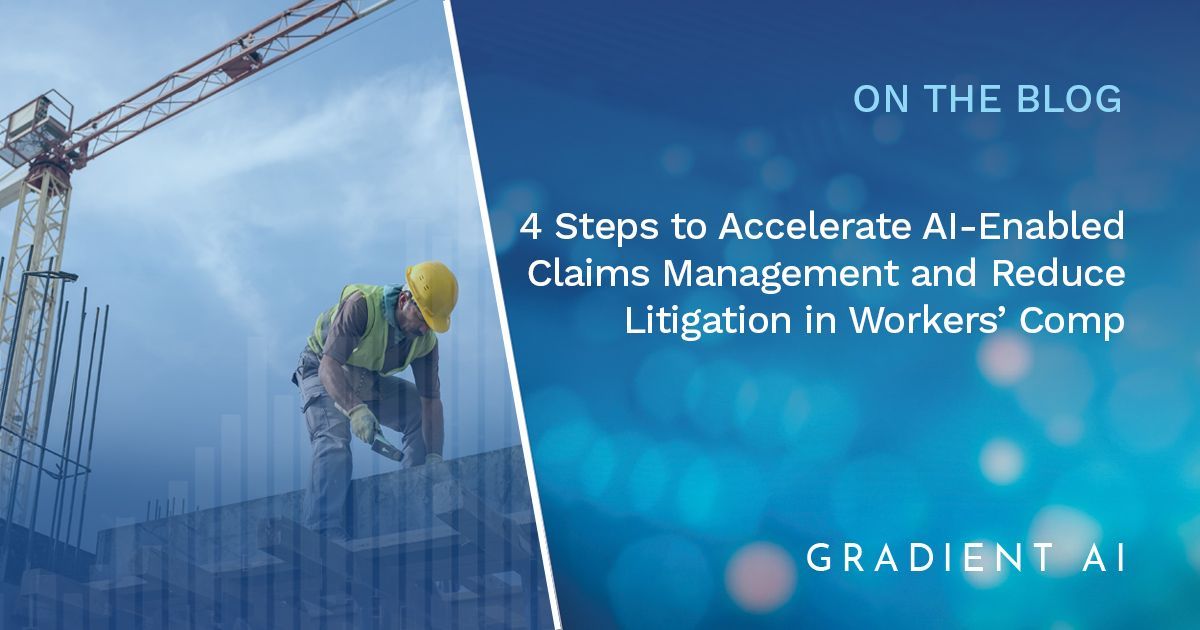4 Steps to Accelerate AI‑Enabled Claims Management and Reduce Litigation in Workers’ Comp
In Workers’ Compensation insurance, time is money, and delays can be costly in more ways than one. The longer a claim lingers, the greater the chance it will escalate, involve attorneys, and rack up expenses. Once litigation enters the picture, timelines stretch, adjuster workloads grow, and claim costs can skyrocket.
The challenge? High-risk claims don’t always announce themselves early. By the time red flags are obvious, it is often too late to change the outcome. That’s why more Workers Comp insurers are turning to AI-enabled claims management to spot potential problems before they spiral, empower adjusters with real-time insights, and intervene when it matters most.
This article walks through 4 practical steps to integrate AI into your claims process. The goal is to help your team identify risk earlier, resolve claims faster, and reduce litigation rates without overhauling your systems.
1. Use the system you already have
You don’t always need to overhaul your technology to get started. Many AI tools can be activated right within the claims platform your team already uses. With just a few configuration updates, risk scores and alerts become part of the existing workflow.
That means adjusters don’t need to learn a new platform, switch between systems, or attend hours of training. They simply get smarter tools inside the claims system they already know. This keeps disruption low and adoption high, which are both key to getting results fast.
2. Get earlier insight into claims that might go off track
AI can analyze patterns across millions of historical claims and flag early signs of trouble before most adjusters would spot them on their own.
These signals show up early in the claims process, often at the first notice of loss. That gives adjusters more time to take action, reach out to the injured worker, and offer support that may prevent the claim from escalating.
The goal isn’t to replace adjusters. It’s to give them a clearer view, sooner, so they can make better decisions in less time.
3. Lower the chance of legal involvement and reduce costs
Once attorneys get involved in a claim, timelines tend to stretch, and costs increase. AI helps teams identify claims that are likely to become litigated and intervene early, when there’s still time to change the course.
A research study by Gradient AI found that AI-enabled workers’ comp claims management reduced legal involvement in lost-time claims by 15%. This results in an overall 5 percent reduction in claims costs, which translates to more than $3.5 million in annual savings.
These results come from using predictive analytics inside the standard claims workflow, with insights available right when adjusters need them.
4. Roll it out quickly without slowing down operations
One of the best things about these newer AI tools is how easy they are to turn on. Because many are already built into popular claims platforms, it’s often just a matter of flipping a switch and setting up a few rules.
There’s no need for long IT projects or complex integrations. You can activate the AI tools, configure your scoring preferences, and start seeing insights in just a few days or weeks. Operations continue uninterrupted, allowing teams to use the insights immediately.
Final Thoughts: Bringing AI into Claims Management Doesn’t Have to be Complicated
With the right AI solution, you can enhance your current system, give adjusters better visibility into claim risk, and reduce the number of cases that turn into legal battles.
One proven example of this approach is the integration between Gradient AI and Origami Risk, which lets teams activate predictive analytics directly within their existing workflow. Work Comp insurers using this setup have seen faster claims resolution and measurable cost savings without slowing down their teams or adding new systems to manage.
Since Origami Risk and Gradient AI are already fully integrated – providing a simple path to AI-enabled claims management – you’ll gain all the benefits of AI in reducing Workers’ Comp litigation while improving overall claims workflow.
If you're ready to explore how this works in practice, we’re happy to walk you through the results our customers are seeing, and what it would look like for your team.
Stay on top of AI trends by subscribing to Advanced Insights, the newsletter for strategies, ideas, and insights on AI in insurance. Delivered monthly to your inbox. Subscribe Now →


